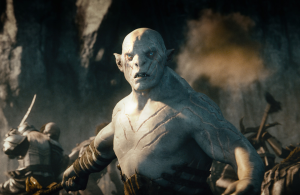by Niall McArdle
We likes Bagginses, we do. We do indeed. And frankly, Precious, we are surprised.
When I heard that Peter Jackson was planning another visit to Middle Earth, my heart sank. Not because I don’t like his Lord of the Rings trilogy. I like it quite a bit, actually, but by the finish of long, drawn-out battle that ends The Return of the King and the trilogy, I was exhausted: nine hours of halflings, dwarves, elves and orcs can tax anyone. Then there were all the DVD releases and extended cuts and special features and whatnot. In short – no pun – I’d had it up to here in hobbits. But The Lord of the Rings, as drawn-out as it was, probably deserved three films; it’s a long, sprawling saga. Tolkien’s prequel The Hobbit is by comparison brief. But there was news Jackson was going to film the prequel as three movies (and rumours that he was even adding bits of his own). Here we go again, I thought, another nine-hour slog of hobbity nonsense.
I was wrong. Having just sat through the first six hours, I now cannot wait until the story is finished with the third film (released this Christmas). The decision to split The Hobbit in to three parts is not a cash grab (okay, it might be a cash grab, but it’s not just a cash grab). The first two parts are exciting, well-written, well-acted, and structured to keep you on the edge of your seat and by the end of each begging for more. Both films look beautiful (New Zealand once again) and they are well-made, with lovely production design and gnarly makeup.
Trick photography and stand-ins (children, presumably) create the illusion by which a character can appear several feet taller than another (there must be some shots using the old trick of having an actor on his knees to make him look short.) There are a lot of special effects in both films, perhaps even more than in the first three. To be honest, I did wonder exactly how much of what I was seeing was computer generated – especially in the second film – and several of the effects shots look like, well, effects shots, and a bit cartoony, which can momentarily take you out of the story.
Set sixty years before the events of The Lord of the Rings, the first film sets up the tale of how the hobbit Bilbo Baggins is asked by Gandalf to leave the Shire and help the dwarves get back into the Lonely Mountain and reclaim their kingdom of Erebor from the dragon Smaug. There are orcs. There are trolls. And there is Gollum and his Precious.
The second film brings us into the mountain, where Smaug sleeps underneath a giant heap of treasure. There are orcs again. And elves this time. And giant spiders. And humans (including Tolkien uber-nerd Stephen Colbert).
At one point in the development of the films Guillermo del Toro was to direct, but he dropped out and Jackson took over. It would be interesting to think what del Toro would have done with Middle Earth (no doubt somewhere on the internet there is a raging debate as to which director would have been better), but as it is Jackson slips effortlessly back into the world as if putting on a well-loved piece of clothing.
Several of the original trilogy’s cast reprise their roles: Ian McKellen, Cate Blanchett, Andy Serkis, Hugo Weaving, Christopher Lee, and Orlando Bloom (looking a little fat around the jowls for an elf). Ian Holm and Elijah Wood also make cameo appearances. New inhabitants of Middle Earth include Richard Armitage, Luke Evans, Graham McTavish, Lee Pace, Evangeline Lilly, Sylvester McCoy, Ken Stott, James Nesbitt, and Stephen Fry. Benedict Cumberbatch voices the evil Smaug (giving a hint as to what sort of Shere Khan he will be).
As fine as all these actors are, it would all be for naught if the title role was badly cast. Luckily, Martin Freeman seems to have been born to play Bilbo. He has the right physique and features (he does indeed look like a young Ian Holm), and the right bearing for the quiet, settled hobbit who is forced to use his wits and find his courage in the world outside the Shire.
The films are long but quick-paced, and although the scale of some of the action scenes is big, most of the action is seen at close quarters and easy to follow (unlike a lot of recent big-budget action films.) And although much of the dialogue concerns silly fantasy nonsense, the themes are decidedly real: loyalty, courage, friendship, and it is refreshing to see movie heroes using their brains to defeat bad guys. I don’t consider myself a fanboy by any means, but I would much rather spend time with these halflings and dwarves than with a host of so-called superheroes.








The slide montage of stills looks very professional Niall!
Not a great fan of the films personally. Having read the books in my youth, I left it to my imagination, not Jackson’s, to realise Middle Earth and all the characters. I cannot deny the scale and talent in the work though. Especially from the IT department. Good appraisal, as always.
Best wishes, Pete.
LikeLiked by 1 person
I just discovered the slide feature on wordpress. If you choose to make a gallery of images, you can select how you want them presented
LikeLike
love this series Niall. LOTR were definitely spectacles to see in the thetaer and eventhough i dont get much time these days to go to the theater, I have made sure to see both Hobbitts so far and plan on seeing the finale too on the big screen
Great review!
LikeLiked by 1 person